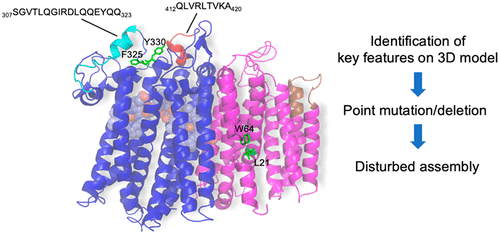当前位置:
X-MOL 学术
›
ACS Infect. Dis.
›
论文详情
Our official English website, www.x-mol.net, welcomes your feedback! (Note: you will need to create a separate account there.)
Features and Functional Importance of Key Residues of the Mycobacterium tuberculosis Cytochrome bd Oxidase.
ACS Infectious Diseases ( IF 5.3 ) Pub Date : 2020-05-07 , DOI: 10.1021/acsinfecdis.9b00449 Ekaterina Sviriaeva 1, 2 , Malathy Sony Subramanian Manimekalai 1 , Gerhard Grüber 1 , Kevin Pethe 1, 2
ACS Infectious Diseases ( IF 5.3 ) Pub Date : 2020-05-07 , DOI: 10.1021/acsinfecdis.9b00449 Ekaterina Sviriaeva 1, 2 , Malathy Sony Subramanian Manimekalai 1 , Gerhard Grüber 1 , Kevin Pethe 1, 2
Affiliation

|
Cytochrome bd (cyt-bd) oxygen reductases have a high affinity to oxygen and use the two electrons provided by ubiquinol or menaquinol, like in mycobacteria, to reduce oxygen to water. Although they do not pump protons from the cytoplasmic to the periplasmic side, they generate a proton motive force due to the release of protons after quinol oxidation. Here, we show that the mycobacterial cyt-bd has a number of specific features, including a 17-residue stretch (307SGVTLQGIRDLQQEYQQ323) near the Q-loop of the Mycobacterium tuberculosis subunit CydA and a 412QLVRLTVKA420 region on the periplasmic side. Site directed mutagenesis and whole-bacteria assays demonstrated that these mycobacteria-specific stretches are essential for the oxidase’s function. Single amino acid substitutions around the 307SGVTLQGIRDLQQEYQQ323 stretch revealed the importance of the aromatic residue Y330 in oxygen consumption and consequently in ATP synthesis. A moderate reduction and no effect was observed for mutants F325 and Y321, respectively, while the double mutant CydAY321/F325 drastically reduced enzyme activity. In addition, single mutants of the mycobacterial cyt-bd were generated to probe the role of proposed critical residues for proton shuffling. Further data demonstrate that amino acids W64 and F18 in the CydB subunit might be important as any slight destabilization of the hydrophobic environment near them makes the enzyme inactive. Finally, the potential of the mycobacterial cyt-bd as a drug target is discussed.
中文翻译:

结核分枝杆菌细胞色素bd氧化酶关键残基的特征和功能重要性。
细胞色素bd(cyt- bd)氧还原酶与氧具有高亲和力,并像分枝杆菌一样,利用泛醇或甲萘醌提供的两个电子将氧还原为水。尽管它们不将质子从细胞质侧泵送到周质侧,但由于在奎诺尔氧化后质子释放,它们产生质子原动力。在这里,我们表明,分枝杆菌CYT- BD具有许多具体特征,包括一个17个残基的伸展部(307 SGVTLQGIRDLQQEYQQ 323)所述的Q-环邻近结核杆菌亚基CydA和412 QLVRLTVKA 420在周质侧。定点诱变和全细菌分析表明,这些分枝杆菌特异性延伸对氧化酶的功能至关重要。307 SGVTLQGIRDLQQEYQQ 323片段周围的单个氨基酸取代揭示了芳族残基Y330在耗氧量以及因此在ATP合成中的重要性。分别对突变体F325和Y321观察到中等程度的降低,但没有发现作用,而双重突变体CydA Y321 / F325则大大降低了酶的活性。此外,分枝杆菌CYT-的单突变BD生成了用于探测拟议的关键残基在质子改组中的作用。进一步的数据表明,CydB亚基中的氨基酸W64和F18可能很重要,因为它们附近疏水环境的任何轻微失稳都会使酶失活。最后,分枝杆菌CYT-的电位BD作为药物靶标进行了讨论。
更新日期:2020-07-10
中文翻译:

结核分枝杆菌细胞色素bd氧化酶关键残基的特征和功能重要性。
细胞色素bd(cyt- bd)氧还原酶与氧具有高亲和力,并像分枝杆菌一样,利用泛醇或甲萘醌提供的两个电子将氧还原为水。尽管它们不将质子从细胞质侧泵送到周质侧,但由于在奎诺尔氧化后质子释放,它们产生质子原动力。在这里,我们表明,分枝杆菌CYT- BD具有许多具体特征,包括一个17个残基的伸展部(307 SGVTLQGIRDLQQEYQQ 323)所述的Q-环邻近结核杆菌亚基CydA和412 QLVRLTVKA 420在周质侧。定点诱变和全细菌分析表明,这些分枝杆菌特异性延伸对氧化酶的功能至关重要。307 SGVTLQGIRDLQQEYQQ 323片段周围的单个氨基酸取代揭示了芳族残基Y330在耗氧量以及因此在ATP合成中的重要性。分别对突变体F325和Y321观察到中等程度的降低,但没有发现作用,而双重突变体CydA Y321 / F325则大大降低了酶的活性。此外,分枝杆菌CYT-的单突变BD生成了用于探测拟议的关键残基在质子改组中的作用。进一步的数据表明,CydB亚基中的氨基酸W64和F18可能很重要,因为它们附近疏水环境的任何轻微失稳都会使酶失活。最后,分枝杆菌CYT-的电位BD作为药物靶标进行了讨论。


























 京公网安备 11010802027423号
京公网安备 11010802027423号